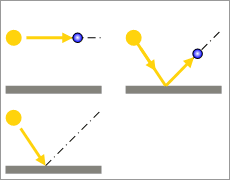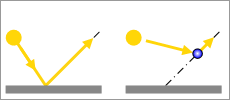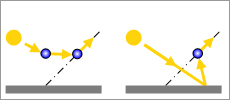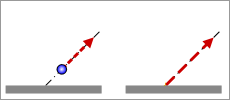The light reaching a satellite spectrometer in any particular viewing direction is the result of the radiative transfer of the sunlight that falls on the Earth and that is scattered in the atmosphere.
The differences between the incident sunlight and the observed light are the result of radiative interactions in the atmosphere and/or on the surface. The observed light may have experienced a single interaction or a number of cumulative interactions, of the same or of different types.
An analysis of the observed light has therefore to take into account the gains and losses that can occur to incident solar light as a result of the following processes in the atmosphere and/or on the surface.
 |
Losses from the absorption of direct or reflected solar radiation in the atmosphere or at the surface. |
 |
Losses from the scattering of direct or reflected solar radiation out of the viewing direction in the atmosphere or at the surface. |
 |
Gains from the scattering of direct solar radiation into the viewing direction in the atmosphere or at the surface. |
 |
Gains from the scattering of diffuse solar radiation (that is, radiation that has already suffered one or more reflection or scattering interactions) into the viewing direction. Gains from radiation that has been reflected from the ground or from clouds and is scattered into the viewing direction. |
 |
Gains from thermal emission from the atmosphere or from the surface into the viewing direction. |
In addition, refraction effects may mean that the light path in the viewing direction is not a straight line.